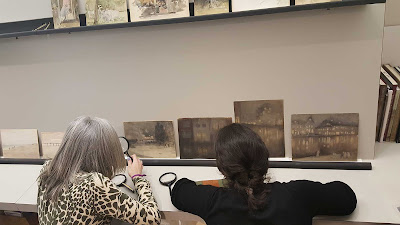In early April, I participated in a three-day hands-on workshop about James McNeil Whistler’s watercolors held at the Freer Gallery of Art in Washington, D.C. Led by paper conservator, Emily Jacobson, conservation scientist, Blythe McCarthy, and the former Freer curator of American art, Lee Glazer, the workshop introduced participants to material examination and analytical methodologies for object-based research. If we learn about the types of pigments, papers, and working methods Whistler used in his practice, how might that data inform art historical research? We engaged in guided and close looking of the fifty-two Whistler watercolors in the Freer’s collection. This often involved inspecting an artwork with a magnifying glass, microscope, or even a light box.
Throughout the workshop, I learned how to identify different types of nineteenth-century watercolor paper, application techniques, and how to interpret multispectral imaging. For instance, Whistler’s 1880s watercolors often fluoresce in ultraviolet light, an indication that the artist mixed zinc white throughout his painting. With this information, we were able to conclude that Whistler found zinc white to be a unifying color in his watercolors, which is in contrast to his preference for black in his oil paintings. We often think of watercolor as an unforgiving medium, but through infrared imaging, we could see that Whistler often made changes to his paintings. I discovered how Whistler became more confident and expressive with the medium. His early watercolors often served as preparatory studies with extensive graphite under- and overdrawing to delineate tonal values and perspective. In contrast, his later watercolors of the 1880s are more experimental, and he tested the limits of the medium. The Whistler Object Study Workshop was an immersive experience enabled me to gain greater facility with American watercolor and new ideas in how to interpret and present Whistler at the Worcester Art Museum.
--Erin R. Corrales-Diaz, Assistant Curator of American Art
May 1, 2019
Welcome to WAM Updates
WAM Updates are short, informal posts that put the spotlight on small, but exciting, Museum-related projects, such as the addition of a new painting or sculpture to a gallery. They also serve as updates on staff, new services or programs, and other WAM news.
We hope you like reading the Updates! If you are interested in learning about something specific, or have a suggestion for a WAM Update, please update us at wamupdates@worcesterart.org
Recent WAM Updates
-
Many people believe that the representation of figures is forbidden in Islamic religion and culture, but this is false. The Qur’an, in fact,...
-
Islamic art covers a vast geographical and chronological spectrum, from Spain to Southeast Asia over 1400 years. Though, despite all the dif...
-
Tournaments! The word suggests images of knightly competition, of jousting, parading, pageantry, and ladies cheering on their chosen hero. T...
-
In the previous section of this two-part WAM Update, we learned how, beginning in the 14th century, European armies began to shift their fo...
-
The Worcester Art Museum is home not only to European arms and armor, but also the arms of other cultural groups including Japanese armors. ...







